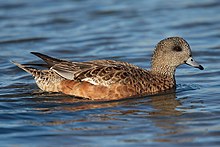North American wigeon
| North American wigeon | ||||||||||||
|---|---|---|---|---|---|---|---|---|---|---|---|---|

North American wigeon ( Mareca americana ), drakes in front and the female behind |
||||||||||||
| Systematics | ||||||||||||
|
||||||||||||
| Scientific name | ||||||||||||
| Mareca americana | ||||||||||||
| ( Gmelin , 1789) |
The North American wigeon ( Mareca americana , Syn .: Anas americana ) is a species of swimming duck that is widespread in northern North America . Its range extends from the middle of Alaska in a wide strip across northern Canada to the southeastern shores of the Great Lakes. It also breeds in the western United States. The North American wigeon is the American counterpart to the Eurasian wigeon . Both in appearance and in the way of life these ducks have a lot in common. The North American wigeon is considered harmless in its population and is one of the most common duck birds to be observed in North America.
Appearance
The North American wigeon reaches a body length of 45 to 55 centimeters. The wingspan is 75 to 90 centimeters. North American wigeons weigh between 600 and 850 grams.
Drakes in magnificent dress have a pink breast and a black rump. The rump plumage is red-brown and gradually turns into a silver-gray towards the back. The back plumage is finely wavy gray-brown. This plumage decreases towards the flanks. The underside of the body is pure white. The wings have a striking white mirror that can be seen both when at rest and in flight. The head is grayish in color with a green stripe that goes from the eye to the neck and ends there in a black and white speckle. The head is straw yellow from the beak to the forehead. The tail has two or three elongated feathers. In the plain dress, i.e. outside the breeding season, they resemble the females.
The females are light brown and thus resemble the female mallard . Based on the body shape, however, it can be distinguished from other species, with the exception of the wigeon. The latter has a darker head and gray undersides of wings compared to the female American wigeon. Overall, the females of this species are colored a little grayer; their plumage shows a purple tinge.
In both sexes, the beak is light blue-gray with a black tip and a black base. The feet are blue-gray.
Occurrence
The North American wigeon breeds in Canada in Saskatchewan , Alberta , Manitoba , Alaska , the Northwest Territories, as well as in the Prairie Pothole Region and the Great Lakes .
It is a migratory bird and winters in Texas , Louisiana, and on the coasts of the Gulf of Mexico . Some animals also occur as rare wanderers in Western Europe .
Way of life
The North American wigeon inhabits open wetlands and feeds on plants by rooting or grazing. Around 90 percent of the diet is plant-based. Vallisneria americana , a species that belongs to the frog-bite family, is one of the preferred food plants . The remaining 10 percent are aquatic organisms that the ducks ingest with their vegetable diet. North American wigeons can often be seen in schools of diving ducks. They steal the aquatic plants from these ducks that the diving ducks bring back to the surface from their dives.
American wigeons arrive from their wintering areas from around May in the breeding areas. The courtship is inconspicuous. The nest is built by the female on the ground near the water. The preferred nesting site is dense bank vegetation or well-overgrown islands. The female lays 6 to 12 cream-colored eggs. The interval between laying eggs is around 24 hours. Breeding begins when the clutch is complete. Only the female breeds and raises the chicks on her own. The male remains near the female until the start of moulting. The young birds are usually fledged after 45 to 63 days.
supporting documents
Individual evidence
- ↑ Sale, p. 110
- ↑ Kästner, p. 48
- ↑ Christopher S. Smith: Field Guide to Upland Birds and Waterfowl , Wilderness Adventure Press, Belgrade (Montana) 2000, ISBN 1-885106-20-3 , p. 68
- ↑ Kästner, p. 48
- ↑ Christopher S. Smith: Field Guide to Upland Birds and Waterfowl , Wilderness Adventure Press, Belgrade (Montana) 2000, ISBN 1-885106-20-3 , p. 68
- ↑ Gooders and Boyer, p. 34
literature
- John Gooders and Trevor Boyer: Ducks of Britain and the Northern Hemisphere , Dragon's World Ltd, Surrey 1986, ISBN 1-85028-022-3
- Manfred Kästner: Gründelenten , Urania Verlag, Leipzig 1994, ISBN 3-332-00546-4
- Richard Sale: A Complete Guide to Arctic Wildlife , published by Christopher Helm, London 2006, ISBN 0-7136-7039-8
Web links
- Mareca americana in the endangered Red List species the IUCN 2008. Posted by: BirdLife International, 2008. Accessed January 31 of 2009.
- Videos, photos and sound recordings about Mareca americana in the Internet Bird Collection


